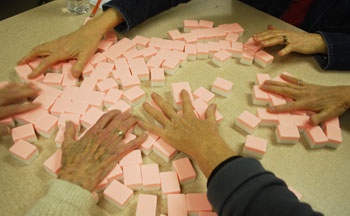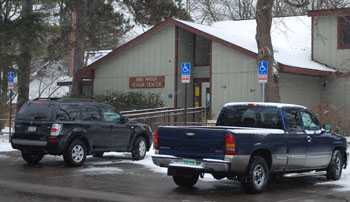Twittering at the Ann Arbor Senior Center
The sound is like heavy rain clattering on a tin roof. “It’s called twittering – yes, we know how to twitter!”

This kind of twittering is also social and interactive – to shuffle the Mah Jongg tiles. (Photos by the writer.)
The “we” is a group of six who’ve come to the Ann Arbor Senior Center on a frigid Monday afternoon to play Mah Jongg, and they’ve graciously allowed The Chronicle to sit in on their game.
It’s a slow day at the center – typically, there might be 16 or more people here to play the traditional Chinese tile game, plus another couple dozen playing bridge – but wind and snow and perhaps the holiday weekend made for a thin turnout.
The Chronicle has covered two meetings of a city task force that’s trying to save the center – it’s slated to close on July 1, unless the task force can come up with ways to cut expenses and raise revenues to overcome a $151,687 operating shortfall.
But we hadn’t yet visited the center to see what goes on there during a typical day. So on Monday, we made the snowy trek.
Getting There
At a meeting in October, city staff laid out an array of challenges facing the center. One of those issues was the fact that the building at 1320 Baldwin Ave. isn’t on an AATA bus line. [See Chronicle coverage: "Seniors Weigh In on Fate of Center"]
At the meeting, there was some discussion about whether it was important to actually be on the bus line – someone pointed out that the closest stop on Packard, near the intersection with Granger, was just four blocks away.
It’s a long four blocks. That’s especially true in inclement conditions, when fewer than half of the sidewalks in the residential Burns Park neighborhood had been cleared. Taking the No. 5 bus from the Blake Transit Center to the Packard/Granger stop takes about 10 minutes – and that’s about how long it takes to walk from Packard to the senior center.
The AATA does offer some services for seniors, including the A-Ride program for people with disabilities. But based on the dozen or so cars in the senior center parking lot, most people on Monday drove themselves, or hitched a ride with a friend.
Any Given Day
Lunch is served at the center on Mondays, Tuesdays and Wednesdays for $2.50, or $5 if you’re under 60 years old. (Several people at the task force meeting said the price was too low, and suggested charging more.) On Monday, the menu included lemon chicken, boiled potatoes and mixed vegetables.
But The Chronicle arrived just after the meal had wrapped up, and found people already settling into the afternoon. In the lobby, one man is sitting in an easy chair, watching a large TV. Across the room, another man is set up at the center’s public computer – one of three that are available for use, with Internet access.
But games are where the action is. Duplicate bridge is normally played in the main room, but on Monday not enough people had showed up for the multiple-table play of duplicate bridge. Instead, four people are sitting around a card table, playing a single game – of social bridge. The distinction between social bridge and “sanctioned” bridge is an important one, we learn. Games that are sanctioned by the American Contract Bridge League (ACBL) are held on Thursdays, when the place is typically packed and points are recorded in an official ACBL database.
Ray Gentz, one of the four bridge players on Monday, says it’s rare to find him playing social bridge – sanctioned games are his thing, at the senior center and elsewhere. He also teaches bridge through the Ann Arbor Rec & Ed program. Gentz says he’d be interested in teaching at the center too, but that so far, the scheduling hasn’t worked out to make that possible.
Also playing bridge on Monday are Kermit Schlansker, Flo Shepps and Connie Craft, who hosts the Senior Moments show on Community Television Network. Bridge players in general have a reputation for being serious – we’re told this by the more boisterous Mah Jongg players in the back room. Even so, when The Chronicle asks her name, Craft deadpans: “Santa Claus.”
“Twittering of the Sparrows”
Monday afternoons also bring Mah Jongg players to the senior center. They’re in the back room, playing at two tables of three – normally, there’d be enough people to play four per table, filling up several more tables. But what they lack in numbers they make up for in good cheer – unlike the more serious bridge players, they tell The Chronicle, they’re just here to have some fun.

From left: Kurt Rinker, Janice Beatty, Jack Beatty and Jeannie Tramontan. Rinker was just visiting – not a player.
They’re playing a variation of the traditional Chinese game – not the more difficult American version. Everyone defers to Maxine Solvay as the expert in the American, or New York, Mah Jongg. She explains that growing up in New York, her mother taught her and her two sisters how to play, so that her mother “could always have a game.”
For the American version, cards are issued each year by the National Mah Jongg League, which dictates the kinds of hands that can be played during the year. Solvay has cards of her mother’s dating back to the early 1950s. She also keeps a Mah Jongg set in her car, just in case.
The mention of a spare set in her car earns Solvay a bit of good-natured ribbing from the others, before talk turns to where you might buy your own Mah Jongg set. Janice Beatty suggests the large Asian market on Washtenaw Avenue, across from Norton’s Flowers – that’s where she and her husband Jack bought theirs. (Hua Xing Asia Market, at 2867 Washtenaw Ave.)
A game ends at the table where Solvay, Margaret Leslie and Peggy DeVries are playing – they shuffle the pink and white plastic tiles, which make a distinctive clicking sound that we’re told is called “twittering.” The homophonic connection to Twitter, the online social networking platform, is noted with laughter. Janice Beatty pulls out a sheaf of papers to find the exact term. The papers contain “Stuart Baggaley’s Rules” – Baggaley teaches the game at the center and elsewhere – and indeed, she finds a description of “twittering of the sparrows.” There are also explanations of kong, peng and chow, but we’ll save that for another day.
As we’re talking, a man wanders in and weighs himself on a scale in the back of the room, then leaves.
Programming, Membership Fees
Mah Jongg isn’t the only thing that brings these people to the center. Margaret Leslie takes two French classes here, taught by Jim McMurtrie and Lucie Osborn. Osborn has been teaching at the center since she retired from the Ann Arbor Public Schools nearly 25 years ago. “She’s very much loved,” Leslie says. That class is mostly conversational, but they also sing songs and recite poetry. McMurtrie’s class also includes conversation, as well as grammar and reading. When Solvay makes a face at the mention of grammar, Leslie insists, “No! It’s very, very fun.”
The senior center task force is recommending that the center raise revenues through programming – adding to the number of programs it currently offers, like bridge and tai chi, and expanding the types of programs. That might include adding a lecture series, for example, or different types of exercise classes, like Pilates or Zumba.
Peggy DeVries says she’ll be taking a tai chi class at the center that starts in January, and will be part of a book club that’s also gearing up next month. Jeannie Tramontan has taken line dancing, and Janice Beatty mentions that Susan Boyle teaches a popular watercolor painting class that’s offered at the center through a Washtenaw Community College program.
Leslie notes that WCC lifelong learning courses are free if you’re over 65, but otherwise there’s a fee. “We’re all under 65 here, dear,” Janice Beatty quips. “It’s just that we’re having a bad hair day.”
The group talks about other discounts – Nicola’s Books offers 10% off to seniors on Wednesdays, and Tuesdays you can get cheaper movie tickets at Quality 16. So deals are clearly important. But when asked whether they’d be willing to pay a membership fee for the senior center, everyone in the room quickly said yes. Several people added that they’d like to see more of an emphasis on soliciting donations as well, and making it easier for people to give tax-deductible contributions to the city, earmarked for the center.
The idea of a membership fee has been floated by the senior center task force, and will likely be among its final recommendations. City staff estimate that a $25 fee would raise $12,500 annually – an amount based on 500 members, the number of current users of the center. [See Chronicle coverage: "Task Force Tries to Save Senior Center"]
The Competition
Only one person we queried at the center said she would not be willing to pay a membership fee, regardless of the amount. She explains that’s because she more frequently uses the senior centers in Saline and Pittsfield Township – she’s only in Ann Arbor on Monday afternoon because there’s no programming this week at the other locations.
In general, Saline’s center gets props for its longer hours and freebies, while Pittsfield’s center is cited for its superior facility and trip programs. The task force for the Ann Arbor senior center is looking at expanding its own trip programs – they estimate that such a move could raise $3,390 in net revenue annually, possibly more.
Another place for seniors is the Turner Senior Resource Center on Plymouth Road in Ann Arbor, operated by the University of Michigan Geriatrics Center. Turner is known for its wide array of programs. Margaret Leslie takes French classes there as well, but notes that it’s not the kind of place where you can go and just hang out. “People here know my name,” she says. “Turner is not like that.”
What’s Next?
The senior center task force is holding its next meeting at the center on Wednesday, Jan. 6 at 4 p.m. Recommendations about ways to cut expenses and raise revenues are expected to be presented to the city’s park advisory commission at its Jan. 19 meeting. Those recommendations, and whatever revisions that PAC members make, will be forwarded to city council as part of the overall budget process.
The council is expected to make its final budget decisions by May.




